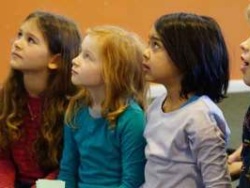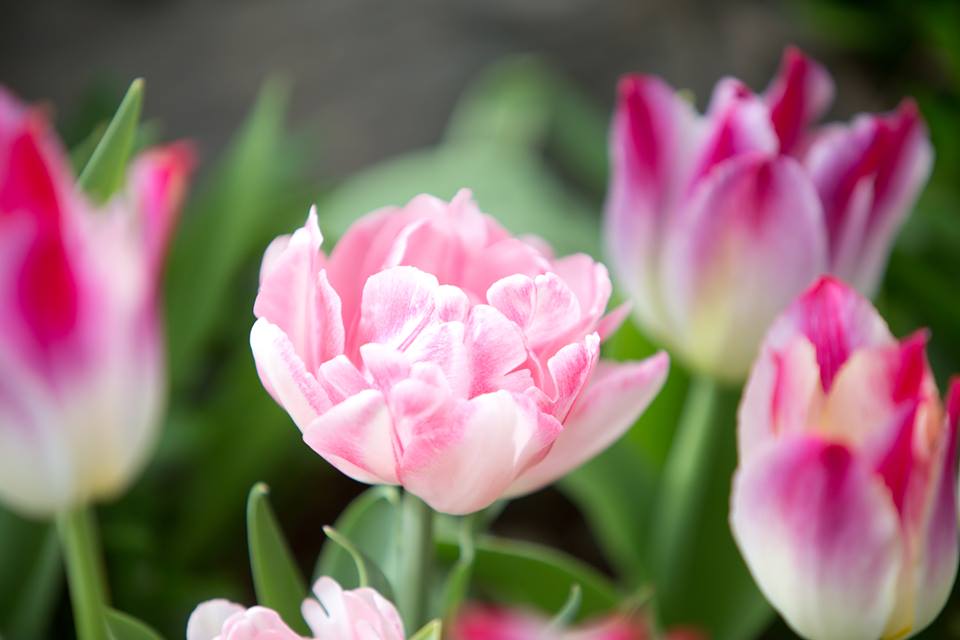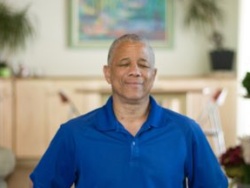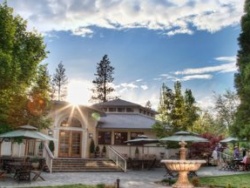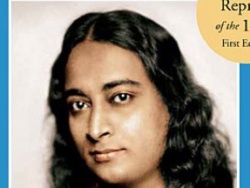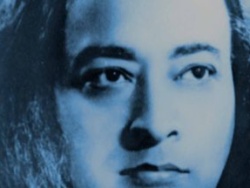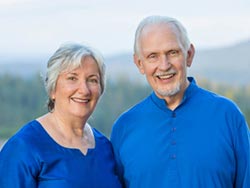Like most people at Ananda, I’ve always had an intense desire to find truth. I was raised Episcopalian, but my church experience didn’t seem to answer my questions, so I turned away from religion and toward science, and especially psychology. In high school, I wrote a thesis on dreams, and later I studied psychology and the humanities in college. I graduated from the University of Minnesota in 1966 and immediately moved to California. The study of psychology still left me unsatisfied, so I started looking into alternative spiritual views of life, reading Native American mythology and the Tibetan Book of the Dead.
During this period I came across Autobiography of a Yogi, by Paramhansa Yogananda. Reading this book was, by far, the most profound spiritual experience I’d had in my life. But, it created a conundrum for me. I knew intuitively that Yogananda knew the truths I was looking for, but his book challenged my logical, rational, scientific viewpoint. Here were passages that spoke matter-of-factly about miracles, and samadhi, and a universe very different from mine. I had to choose whether to hold to my logical, scientific view of the world, or to accept that there could be something much vaster.
In the latter part of 1966, I heard about a direct disciple of Yogananda who was living in San Francisco and went to meet him on a Sunday afternoon a week or two later. I knocked on the door of the apartment building where he was living, introduced myself, and that’s how I first met Swami Kriyananda.
I find it interesting that my very first contact with Kriyananda set the pattern that was to continue for the rest of my life—he asked me to help him with his work. He was doing a mailing for a class, so virtually his first words were, “Well, come in and, if you’d like, you can help with this mailing.” So that’s what I did. Afterwards, four or five of us went to Golden Gate Park for a picnic. The conversation drifted to the food we were eating, and he talked about the spiritual and psychological qualities of different foods. Later he sang a couple of songs and told some stories about his time with Yogananda. It was, to say the least, an intriguing afternoon.
In the years before he founded Ananda, Kriyananda’s primary activity was teaching yoga classes. In March of 1967, I took one of his six-week class series. In fact, I took this same series three different times within a year, and I began volunteering, helping out a little bit with projects that he was working on.
In 1967, Kriyananda purchased land in the foothills of the Sierra Nevada Mountains for a meditation retreat. I first went there with him in September 1967 to help put up a geodesic dome that was to be the first building. We worked all day Friday and Saturday trying to construct the dome from a kit. By the end of Saturday, we had put together the various hexagons and pentagons that form a dome’s structure. A geodesic dome, like any arch, is very strong once all the pieces are in place, but until that time, it’s quite fragile. We had assembled all of the parts except the final pentagon that would lock everything else into place, and were working furiously to finish. But, gravity beat us. The unsupported struts gradually began to collapse under their own weight. They started falling slowly and majestically and then faster and faster until they splintered into a heap at our feet. And so, the end of Saturday saw everything in ruins.
On Sunday morning I could see that Kriyananda had distanced himself a bit from the other four of us who were helping. My assumption was, “Well, of course. We had a big failure yesterday, and he needs to be alone so he can brood.” Then I heard something. He was lying in the early morning sun, saying something very softly. What I finally heard was “Ah, joy! Ah, joy!” That, more than any lecture, showed me that he had found a level of contentment within himself that wasn’t dependent on outward circumstances. After that incident, I began to take the path much more seriously. Over the next year I became more involved, but I still kept my distance.
In the spring of 1968, I had a superconscious dream that changed my life. In the dream, I was walking through an open meadow in a forest carrying a fishing pole. I soon came to a cave, and in the cave was an underground stream. I knew I should fish there. I threw the line in, immediately felt a tug on it, and pulled up a fish. I’ve always had puns run through my mind and here, in what was the most significant dream I’ve ever had, a triple-pun occurred.
When I pulled up the fish, I could see it was a sunfish. As I was removing the hook from its lip, the sunfish turned into a face representing the sun with flames for hair. But, as I looked more carefully, I could see that the sun had the face of a child, and I realized that it was Jesus, the “Son” of God. As I was looking into the child’s eyes, he said to me, “If you want to know what it is like to be a fish, you’ll have to learn to swim in the stream.” Then it turned back into a fish, and flipped back into the water. I immediately woke up and spent the rest of the night in meditation. That dream was a turning point for me, because at that time in my life, I was debating how intensely to get into yoga. The dream led me to make a deep life commitment to the spiritual path. I soon quit my job as a social worker and became Kriyananda’s assistant.
In early 1968, during the time we were both still living in San Francisco, Kriyananda called a meeting to discuss the idea of forming a cooperative community on the retreat property. The meeting turned out to be a disaster. Only about 10 people showed up, none of whom wanted to live in a community. Several spoke at length about why such a crazy venture couldn’t possibly work. After that meeting, seeing that people needed a clearer vision of communities, Kriyananda wrote the book, Cooperative Communities: How to Start Them and Why.
About a year later, in the spring of 1969, Ananda really got started, and I served as the general manager for the first ten years. In the first year, we faced three major challenges. First, we had to build consensus that Ananda was dedicated to Yogananda. The second challenge, perhaps the most difficult, was establishing a community that could actually survive. Then, in spite of the tremendous financial burden, we realized that we needed to buy land that was separate from the meditation retreat in order to start a community.
Not everyone came to Ananda for the same reasons. Kriyananda moved up from San Francisco in April 1969 and by June there were 25 or 30 of us living at the retreat. But only about half of the people were really committed to the yogic path. Others were willing to try meditation, but more as a pastime. They were here primarily because they wanted a commune in the woods, a popular concept at the time. As more people, especially families, arrived it became apparent that an active community and a meditation retreat each had distinct needs. So we bought several hundred acres about five miles away.
Within a month or two, dozens of people started to arrive at Ananda hoping to live here. Having a lot of newcomers and being split between two separate pieces of property made it more difficult to keep our original ideals in clear focus. Gradually during the first summer, we began to polarize into two groups—those wanting to be disciples of Yogananda, and those here for a communal experience. By fall the community had grown to 50 or 60 people and the differences had grown to the point where they had to be confronted. Finally, Kriyananda called a meeting and said, “We can’t have it both ways. If you want a community without Yogananda, without being his disciples, then I’ll leave. But if you want me to stay, then either you have to be committed to my vision or you need to move on.” He didn’t impose his will, but he made it clear that people needed to make a choice. I’ve always appreciated his non-attachment, being ready to leave everything behind if that was what people wanted. Fortunately, most of us wanted a spiritual community. After the meeting, about 40 percent of the population left.
The remainder of us got busy figuring out how to survive the winter. Our first need was for shelter, and we put up fifteen or twenty teepees, simple but beautiful living spaces. At the time Ananda was founded there were literally thousands of attempts to start communes, yet only a very small percentage of them made it past their first summer. Much to our amusement, only three months after we started, a professor from Davis interviewed people here to find out how our community had lasted so long!
In order to survive we also had to find ways to earn an income. We got some money from retreat activities and publications, but that only supported a small number of people. Over the first winter Kriyananda paid the land payments from income he earned teaching classes in Sacramento. A few of us saw the need to create businesses so people could have jobs. In the winter of 1969 I started an incense and oils business which eventually employed over 20 people. By God’s grace and a lot of hard work we made it through the first winter.
The next year we started the daunting job of organizing the community. We had a huge task in front of us, needing to plan and build a small village, start businesses, and keep a deep, sincere spiritual life in spite of all the activity. We had no experience and no models to follow. But we had energy, ideals, and the blessings of Yogananda.
Community planning has always occurred on an organic level. The first year most of us lived very simply in teepees. But, for the long range, we had to build houses and all the infrastructure of roads, water, and power that goes with them. Initial community (non)planning was driven by two forces—the desire for privacy, and the need to get a road and water to your structure. Those two dynamics produced scattered, uncoordinated clusters of houses, and we soon realized that we needed more foresight. But, it wasn’t until after a forest fire destroyed all our houses in 1976 that we did any serious planning. By then, both county building regulations and our own desire for a more conscious community drove us to create a “Master Plan” for Ananda.
Amidst the flurry of building homes and starting businesses, we managed to keep a very strong spiritual focus. Kriyananda gave Sunday services and spiritual classes weekly and, in the beginning, his magnetism was the primary force keeping our consciousness focused on God. Gradually, as we matured spiritually, there developed a large group of people who were unshakably committed to the yogic path. But it took some years to establish a strong spiritual magnetism.
In June of 1976 we had a forest fire that reduced Ananda to a pile of ashes. The fire started several miles from the community, and we could see smoke for quite a long time before we realized our property was being threatened. Then, the fire began moving our way. There was a road on a hillcrest that we hoped would be a natural firebreak. Having gotten myself into a warrior mood to fight the fire, I somehow had the idea that I could put the fire out, or at least slow it down. Wearing a backpack water pumper, I went down about 100 yards into a field of knee-high grass that bordered the road. The fire hit the grass and charged up the hill. I was standing there with my little backpack pumper, which was really kind of a glorified squirt gun, when I realized my folly and started to run back up the hill. When I looked back, I could see that the flames were rushing toward me much faster than I could run. So I turned around and ran down the hill and jumped through the flames into the part that had already been burned, because otherwise I would have just been caught and burned.
Much to our horror, the fire jumped the road as if it wasn’t there and began to move through dense brush towards one of our housing clusters. The flames were soon 10 or 20 feet high and starting to top into the trees. My wife, Devi, and I had a geodesic dome about 300 yards from where the fire was burning, so I hurried back down to our house. I tried to save the house by cutting a trench around it and hosing it down with water. I knew I had only ten or fifteen minutes before the flames would reach our home and I was, by this time, thoroughly into battle mode, ready to fight the forces of nature.
A teenager, Dwayne Smallen, who was probably only 14 or 15 years old, came down the hill in a truck very excited. He shouted, “You’ve got to get out of here. There isn’t a chance that you can save the house. The flames are really high and will be here in five minutes.” I looked up the hill and saw this enormous wall of fire. It was 500 yards wide and 40 feet high, and it was obvious my little trench wasn’t going to save anything.
At that point I went into a state of complete detachment, saying to myself, “I’m not attached to anything. This house is yours, God. If you want to take it, go ahead. Take everything.” Dwayne had the presence of mind to yell, “Grab what you can and throw it in the truck.” As it happened, Devi had recently boxed up everything in our meditation room to clean it, so I grabbed the things from our meditation room, took an armful of clothes from the closet, and that was it. We threw it in the truck and drove downhill through the brush and out of danger.
Devi had just given birth to our son and had taken him, now 10 days old, to a doctor for his first check-up, so she wasn’t here during the fire’s outbreak. By now it was mid-day and she had come back from town. On her way, about a mile from Ananda, she came to a police barrier. This was the first she knew that Ananda was burning. By the time she forced her way past the barrier and arrived in the community, it was total chaos. There was smoke all over the place, so you couldn’t see anything clearly. You could hear propane tanks bursting like bombs up in the hills. Planes were buzzing over at tree top level dropping borate. It looked and felt like a war.
Devi was in the midst of this war zone trying to comfort our 10 day-old infant. She didn’t know if we still had a home. She didn’t know if we had a community left. She didn’t even know if I was alive or dead. When I got to our little market, where people had gathered, I saw her for the first time since the fire started. I put on a big smile because I didn’t want her to be worried, and she did the same for me. I was trying to find a way to break the news about our house and comfort her at the same time. Our dome had leaked like a sieve during the rains so my first words were, “Well, we don’t have worry about leaks anymore.”
Only days after the fire Ananda began to rebuild itself. Because of our strong foundation in meditation, there was no sense of devastation, which was so prevalent among our neighbors. We knew we would have to put out a lot of energy, but the challenge of rebuilding was exciting rather than distressing. After the fire, about 15 members left and the rest of us started rebuilding the community. Most of our neighbors collected large sums of money by threatening to sue the county, whose equipment had caused the fire. But we, at Ananda, chose not to ask them for anything. Kriyananda wrote them, “We came here to give not to take.” God, and generous friends, saw to it that our simple needs were met.
As we developed, one of the issues we faced was how to make decisions. Kriyananda, from the start of the community, was the type of leader who let others take responsibility and make their own decisions. By empowering people, he was much more subject to the vagaries of human nature, but it allowed everyone to develop their own strength. Self-determination has always been a basic principle at Ananda. As soon as people were willing to take responsibility, we gave them not only responsibility, but also authority—the right to make decisions, and to experience the successes or failures of those decisions. Everyone had control over his or her immediate area. If a person was running the fruit and vegetable department in the market, then he or she decided what to buy, how to display it, and so on. We always avoided the kind of micro-management style that produces an ever-expanding manual of “policies and procedures.” I would call the management style that permeates Ananda, “management by willingness.” As soon as someone begins to show the willingness to take responsibility, he’s given the opportunity.
Naturally, there are people who take responsibility, but aren’t good at making decisions. Good leaders try to tune in to what is trying to happen in any situation. In a spiritual community we always have to try to tune in to the will of God, and try to intuit how it would express itself in any given circumstance. The more we’re able to do that, the more a flow of grace and attunement comes into our work. While attunement to God’s will is sometimes present in religious works, we’ve demonstrated that it can be there in the workplace as well.
At Ananda we define the spiritual life much more in terms of what we do than what we don’t do. The yogic path is based upon controlling and directing energy in a positive flow. It teaches us to transmute energy wasted in worldly desires into desire for union with God. And, most importantly, it gives us techniques to do so. Spiritual success comes much more quickly through developing right attitudes than by trying to suppress desires. Meditation helps us quiet the mind so we can perceive the eternal presence of God within us.
In the past religion tried to restrain what were seen as innately sinful tendencies in mankind. In traditional monasteries, control was achieved through vows of poverty, celibacy and obedience. These vows regulate the flow of life-force in the first three, materialistic, energy centers or chakras, which govern security, sexuality, and power. But, unless the subconscious mind is ready for this step, such forced control feels repressive and produces a backlash.
There is a dual tendency in the psyche of American culture. Many see human nature as innately sinful and therefore needing to be controlled by rules. Others rebel. Look at the stories presented by the media, and you’ll see the rebellious backlash expressed as a lust for wealth, excessive sexuality, and the anti-authoritarian hero who ”won’t take nothing from nobody no how.”
One extreme says man needs controlling, and the other says, “there’s no way you’re going to discipline me.” Both of these approaches are simply inappropriate ways to deal with one’s life-force. At Ananda we use a much more moderate approach, trying neither to harshly control nor freely express human nature. We try simply to direct our energy gently toward that which will bring us lasting happiness.
I would say one of the most important things for community members is to have an expansive, accepting attitude towards life. Accept life, accept people. Rather than seeing how other people “differ”, feel how they are “similar.” Enjoy their ideas, even though they may vary from your own. If the religions and the nations of the world could practice this simple concept, it could transform the world.
The benefit of living in a spiritual community is that it lets you see how God shines through a large variety of people. When you’ve been close to people for a long time and become friends, you can really open your heart to them. When you’re having a difficult time, you can always find someone at Ananda who can lift you up and give you a model, or an example. Different people in the community excel in different things. One person might have great courage. Another may be a model of endurance, a third person joy, yet another devotion. You have all these wonderful examples to help you through the rough spots.
The essence of life at Ananda is attunement to God and to the universal consciousness that Yogananda expressed. We do this most deeply through meditation, by quieting the mind so we can hear the whispers of our own soul. That’s what the yogic path is all about.



